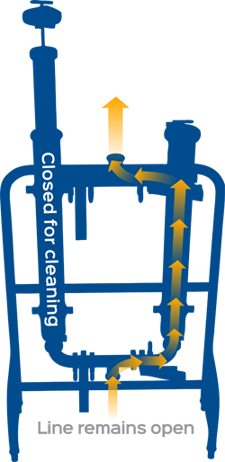
 The biggest issue that takes a positive displacement pump offline is foreign objects in the fluid. Screws, bolts, rocks, etc can render a pump unusable. A strainer can be considered an insurance investment that can protect you from expensive replacements and downtime. There’s more to selecting a sanitary strainer than just making sure that the holes are small enough to catch what you want to catch. Proper strainer selection means the choice you make is industry compliant, the most efficient, and most cost effective, for the application. Sani-Matic shared the top 5 questions you need to answer to make sure your next sanitary strainer is optimized for your process.
The biggest issue that takes a positive displacement pump offline is foreign objects in the fluid. Screws, bolts, rocks, etc can render a pump unusable. A strainer can be considered an insurance investment that can protect you from expensive replacements and downtime. There’s more to selecting a sanitary strainer than just making sure that the holes are small enough to catch what you want to catch. Proper strainer selection means the choice you make is industry compliant, the most efficient, and most cost effective, for the application. Sani-Matic shared the top 5 questions you need to answer to make sure your next sanitary strainer is optimized for your process.
In some industries, like dairy, food, and pharmaceuticals, certain requirements and standards must be adhered to when it comes to production equipment. Understanding those requirements (and making sure your distributor knows too!) will ensure you get equipment that is compliant to agency standards.
 We’ve stressed the importance of proper materials of construction selection when it comes to pumps and valves. Strainers are no different.
We’ve stressed the importance of proper materials of construction selection when it comes to pumps and valves. Strainers are no different.
For example, if you’re pushing a viscous product through a perforated insert where anything over a 20 psi pressure drop occurs, your perforated inserts will repeatedly collapse.
Gasket elastomers could also fail due to degradation in certain processes. EPDM elastomers breakdown in protein processes with fats and oils. This process requires Buna-N or Viton instead.
You’ll save yourself a lot of time and money in the long run if you fully understand your application upfront.
This is all about process optimization. Knowing the process’s flow rate and line size will ensure you’ve got the right size sanitary strainer for the job. The information you provide may also determine needs beyond strainers that are required for an efficient process, like a larger pump size.
Plugged strainers can bring production to a grinding halt. If you’ve employed the wrong strainer, you may find yourself stopping the process several times for repeated cleanings. To prevent this from happening, you may want to employ a dual or duplex strainer assembly that allows for cleaning of one strainer, while the other remains in operation. It may also make sense to just get a larger strainer body.


And finally, are you catching what you want to catch? Product integrity is at stake here, the right strainer ensures you’re getting repeatable, perfect results.
Choosing a sanitary strainer seems like a simple thing, but it’s not always. There are many important questions to be answered to make sure you get the right one without compromising product quality, safety, and cost. Before your next strainer or filter purchase, be sure to speak with an engineer, experienced in selection.
Viking Pump Lid-Ease Basket Strainer

Need to make sure you select the right strainer for your process? Ask us about it! We gladly provide technical assistance to businesses and municipalities in Wisconsin and upper Michigan.
These Stories on Filters
Headquarters and Service Center
Located outside Green Bay, WI
707 Ford Street
Kimberly, WI 54136
920-733-4425
OptiFlow Design and Build Center
1002 Truman Street
Kimberly, WI 54136
920-733-4425
Burnsville Service Center
12265 Nicollet Avenue
Burnsville, MN 55337
952-444-1949
Grand Rapids Service Center
26489 Industrial Blvd
Cohasset, MN 55721
952-444-1949
© Copyright 2024. Crane Engineering. All Rights Reserved. Privacy Policy.